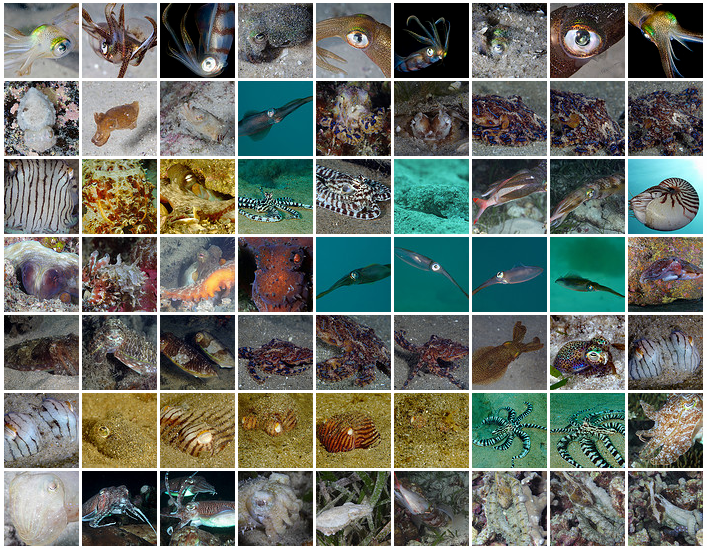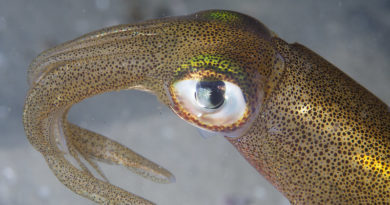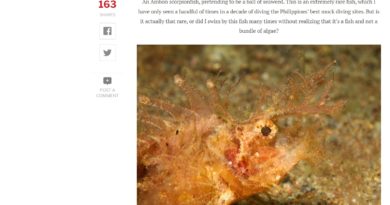Cephalopodophilia
Cephalopodophilia – the (platonic!) love of cephalopods. It befalls so many scuba divers! To understand why that is so, read this sample chapter of my book “Sex, Drugs and Scuba Diving” about the highly fascinating octopi, cuttlefish and squid, the cephalopods.
“The creature hovers just a few meters from me, fixating me with its slitted eyes. It knows I’m there, but does it know that I have seen it? I hover very carefully a couple of arm’s lengths away from it, and avoid any harsh movements. Still, I am bigger than the intelligent alien I am facing, and it is rightfully afraid of being eaten – I have devoured some of its kind fried, breaded or in vinegar.
As I move a bit closer, it realizes that it has been spotted, and lifts itself up from the sand. Its drab brown camouflage coloration almost instantly changes into a whitish body pattern with thin brown lines, an iridescent blue frame and a single uniform brown spot. The spot flashes, and the creature dashes away, settling a couple of meters further from me, on the ground. It now goes back and forth between the white coloration – “I am afraid” – and the brownish mottled pattern – “I want to hide”. That is what the creature seems to be saying, in its two-dimensional visual language.
The unusually smart creature, and I have no doubt now that it is a truly exceptional beast, finally settles in the brown body surface mode, and takes another close look at me. It raises two of its tentacles and wiggles them in a position reminiscent of a raised fist – two out of ten fists raised, that is. I am fascinated. I stay with him, or her, for a while, and we are circling and observing each other. Finally my inability to breathe in his environment and the diminishing amount of air in my tank forces me to return to my own world.

If you want to have such an encounter and don’t want to get wet, you will have to wait until mankind develops interstellar spacecraft, and that might be a long wait. Even then it could take a very long while until we run into anyone as amazing and smart as a cephalopod. As a diver, you have the chance to interact with octopi, cuttlefish and squid (animals grouped in the class of the cephalopods) often only a brief swim from shore in many of the world’s oceans.
A cephalopod is a type of mollusk – a relative of such slow and unresponsive creatures as clams and snails. In German, a language with such utter brilliance in coining expressive nouns (yes, I know I am biased), mollusks are termed “Weichtiere”, literally “soft animals”. They all share a soft, squishy body, which is often protected by a hard outer shell. The cephalopods, with the exception of the archaic Nautilus, have lost this shell during their evolution, but, by Darwin!, they have gained other tools in its place: A set of precisely manipulable arms (10 in cuttlefish and squid, 8 in octopi), keen eyesight, a skin that can change color in fractions of a second, and a big brain to coordinate all of that. Cephalopod, literally translated from Greek, means “Head-footer”, fittingly naming the whole group after their bright head and intriguing arms. These arms are outfitted with a series of powerful suckers, which can be used to grab and lift objects. The ultra-rapid extension of the hunting tentacles of squid and cuttlefish (two specialized arms) takes less than 1/10th of a second, and will leave an unlucky fish in a virtually inescapable death-grip. Try catching a fish in a creek with a spear. It’s hard! Most fish are alert and fast-swimming animals. And a squid will often catch fish up to almost its own size.
The brain of cephalopods is completely unlike that of any other invertebrate (The spine-less animals. Remember them from the chapter about the society of the reef?). Instead of a few lowly piles of nerve cells (called ganglia) like its fellow mollusks, the cephalopod brain contains an astonishing variety of neural nuclei and sheet-like (“cortical” in the lingo of the brain scientists) masses of neurons. Such cortices are a hallmark of advanced, powerful brains. The human cerebral cortex, which gives the surface of our brains this walnutish look, and our minds the power surpassing that of any other animal, is a good example. The total brain size to body size ratio is much larger in a cephalopod than in any other mollusk and similar to vertebrates. Cephalopod brains also have a large variety of distinct nerve cell types, another indicator of highly developed brains. Small and large cells and cells branching in a variety of different ways can together accomplish much more thinking than a homogenous mass of similar brain cells.
The cephalopod skin is outfitted with a large number of color cells, the so-called chromatophores. Some of these cells are in a slightly deeper layer, below a tiny circular muscle. If this muscle is relaxed, the deep layer chromatophore shines through. If the muscle is contracted, the skin color cell above determines the current color of the squid skin. This system works at a very fast speed, and it can signal a variety of patterns. The cephalopod skin signals two-dimensional patterns from the brain to the outside world. The information flows in the opposite direction than usual! Many highly evolved animals such as mammals, birds, other vertebrates and insects posses advanced eyes with a retina, a light-sensitive layer at the back of the eye. The retina catches light rays from the outside world to form a two-dimensional image. This primary image is then further analyzed and statistically decomposed first in the retina itself and then in the downstream parts of the brain receiving retinal input. These brain regions then create successively more abstract representations of what was going on in the primary image. Were there animals of the same kind to be seen? What direction did the things in the outside world move?
Now, in the case of the cephalopod skin, the image travels in the other direction. Somewhere in the brain, there is an abstract representation of “I am afraid”. That representation then travels outwards through lobes and ganglia and turns into a more and more concrete representation of the skin. Finally, the tiny muscles around the chromatophores receive the signals to contract and relax in an arrangement to make a white base color with a flashing brown spot near the back. The cephalopod skin has been called an inverse retina. To my knowledge, such a structure is unique in the animal kingdom.
So, what are the things cephalopods accomplish with these sophisticated information processors? What are the things they signal with their unique skin?
I have seen cephalopods do amazing things. When once snorkeling on a shallow reef in the Egyptian Red Sea, I encountered a rather large solitary squid. The elegant, elongated animal was about the length of my forearm. In the clear water under the brilliant African sun, the animal and I circled each other for a couple of highly interesting minutes. The way the reef was laid out we swam circles in front of a dark coral outcropping standing out from a wide field of beautiful white sand. Hence the position of the squid alternated between a spot where it was, relative to me, in front of the dark reef, and a position where I saw it in front of the white sand. Amazingly, the squid changed colors so that its camouflage was always well matched to MY position. When I saw it with the dark reef as a background, the animal adjusted its body color to a dark tone. When I saw it swimming in front of the white sand, it turned its skin white. The amazing thing here is that the squid did not simply choose its camouflage by matching body color to what wass below it. Rather, it adjusted its coloration according to what it realized I would see. It had, to a degree, a model of my mind. Based on what it extrapolated that I was perceiving it switched between a dark and a light body color. A model of someone’s mind, even if only of the type of visual background that person is experiencing at a certain point, is a major, major mental achievement.
Our big-brained, many-armed friends are excellent hunters. In a warm tropical night in Mactan Island east of Cebu, Philippines, I witnessed a squid attack and kill a goat fish only slightly smaller than itself. My expert Filipino dive guide Julian and I were swimming above a shallow area rich in mixed sea-grass and coral growth. It was about an hour after sunset, and the under water world was pitch-black dark. Most fish, among them the goat fish in the last few minutes of its life, were asleep. Squid are usually visual hunters and my guess is that they hunt at night using the tiny amounts of moonlight useless to the human eye. That night though, a good-sized squid, about 25 cm in length, had a lucky break – Julian’s and my under water lights. We were looking for nothing in particular, shining our lights at the reef in front of us hoping, not in vain, that the coral triangle’s biodiversity would come up with something to surprise us.
The squid must have followed us and once we illuminated the sleeping goat fish, it darted towards its victim and snatched it head-first. I didn’t even really understand at first what had happened, but I saw a large squid race around in front of us, so I followed it and started shooting photos of it. Only then did I realize that I had been lucky enough to capture a successful squid hunt photographically. Squid can move by undulating their lateral fins, and by expelling a gust of water from their muscular mantle. The latter method is faster, and the method of choice when a squid needs to get away from a nuisance like a diver. However, with a fish almost its own size stuck in its mouth, the mantle exit was blocked, and the squid had to do with swimming via its fins as fast as it could. That impediment was the reason I managed to snap a few shots before the cephalopod could get away for a big dinner.
Another hunting episode I was privileged to witness occurred in Sunabe, at the west coast of Okinawa in the very south of Japan, at a depth of about 15 meters. Here I could not identify the prey – I assume it was some kind of crab – but what I observed was an amazing display of cooperative hunting. A reef octopus (Octopus cyanea) had settled on a small rock – maybe half a meter across – in the middle of a sandy area. It had detected some kind of prey in the cervices of that rock. The octopus wrapped its arms around the rock and extended the membranes between these arms such that most of the rock was covered. It then started to blow water into the rock’s crevices hoping to flush out the hiding crabs or shrimps.
This complex hunting behavior alone would have been interesting enough. What was astonishing was the group of fans the octopus had assembled around itself. Five or six medium-sized groupers and wrasses were waiting at striking distance around the rock, ready to capture any crab escaping from the octopus’ engulfment. What I was observing was an example of cooperative hunting between an octopus and fishes. To my knowledge, this behavior has not been scientifically described and investigated yet!
The waiting groupers and wrasses at times came too close for the taste of the octopus, and it did not hesitate to lash out at them with a quick jab with one of its many-suckered arms. This established a negotiated distance of about half a meter at which the hunter would tolerate the waiting side-kicks. I have observed such sucker-punching of fishes by octopi also at other occasions, for instance when an octopus was hiding in the territory of a damsel fish and wanted to get rid of the nervous fish. At that time, one quick jab did the trick; in the case of the octopus-led hunting club, repeated punches and pushes were necessary to keep the group of groupers and wrasses at bay.
An old photographer’s old saying (the saying was already old when these old photographers were young) goes that the best camera is the one you have. As you might guess – sigh – I was diving totally camera-less when witnessing this spectacle.
But of course it is also a source of great enjoyment to simply see such an event. Some kinds of cephalopod-behaviors I haven’t yet photographed or seen. Very, very high on my list of things I would still like to witness under water is the ability of some octopi and cuttlefish to mimic other marine life. The mimic octopus, found in Indonesian, Papua New Guinean and Filipino waters, is a master of this art. A slender octopus with a thin head and long arms, it is skilled in posing as a variety of other marine animals. With its arms held together in an ellipsoid shape, swimming close to the sand it resembles a flounder; with its arms extended upwards, waving in the current: a crinoid. Arms bundled together in two strands makes the mimic-octopus look like a dangerous sea snake. What an awesome animal!
An amazing display of cephalopod behavior I had the pleasure of seeing is the fight between two male cuttlefish over the chance to mate with a female. I was diving in Chowder Bay near Sydney, Australia, only a few meters deep, when I saw a couple of cuttlefish of a smaller species of Sepia. The two combatants in conflict over the ten-armed lady’s charms first eyed each other and each attempted to get to the most favorable position next to her. Then very suddenly the fight broke out and each male cuttlefish quickly swung all of their arms in the direction of his competitor. The fight did not last very long and the looer moved away from the female afterwards. While this was happening, the female cuttlefish displayed a blotchy yellow coloration, while the males back showed an aggressive tiger-pattern.
An unforgettable experience for any diver is to witness some good octoporn – in diver’s lingo this is the mating of two octopi. This is not your hasty mating practiced by so much marine life, hoping to get it over with and to hide from the dangers lurking on the reef as quickly as possible. The octopi usually sit on a rock or coral outcropping about a meter apart and the male extends his mating arm and passes a sperm packet over to the female. This mating is initiated and executed in a calm and slow manner, and often the two connected partners sit on the reef for tens of minutes. In the two instances when I had the pleasure to see some octoporn, once in Hawaii and once in Okinawa, in fact I ran out of air before the mating was over. I am not familiar enough with cephalopod reproductive biology to judge if there is an actual biological need for remaining joined for that long – to me it certainly seems that the octopi are enjoying themselves, and that this would be a reason contributing to the long duration of the mating act.
Squid are known to mate in a variety of different positions, which is highly unusual for animals other than humans. It would almost be a waste not to explore the erotic potential of ten arms. And they better make it good – all cephalopods studied in this respect only mate once in their life-times. Very surprisingly for such large brained animals with complex behavior, they lead a brief life of one or at most a few years and then perish after a single reproductive effort. This apparent waste of all this intelligence is in sharp contrast to what is observed in vertebrates. The bigger-brained and the smarter a mammal or a bird is, the longer it typically lives. Parrots, among the smartest of all birds, can live up to a hundred years. Humans are the smartest and the most long-lived primates. It makes sense that if an animal invests a lot of biological energy in growing and maintaining a large brain with the capacity to learn to then use it for a while. For some reason, this evolutionary reasoning does not hold for cephalopods. Why that is so, is one of the big enigmas of biology.

